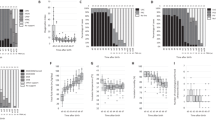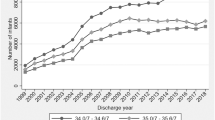Abstract
Objective
To compare the survival and morbidities of infants born between 22 0/7–25 6/7 weeks of gestation.
Study design
This observational cohort study consisted of 187 eligible infants liveborn at a single, Level III Neonatal Intensive Care Unit (NICU) between June 1, 2009, and December 31, 2016, in Cleveland, Ohio. Infants with recognized syndromes or major congenital malformations were excluded from the review.
Result
The rate of survival to discharge for NICU-admitted infants born at 22- and 23- week was 56% and 54% respectively at our institution. There was no trend observed between gestational ages and incidence of necrotizing enterocolitis (NEC), patent ductus arteriousus (PDA), sepsis, or severe intraventricular hemorrhage (IVH- Grade 3 or 4). The infants born at 22 weeks had a higher incidence of retinopathy of prematurity (ROP) as compared to 25 weeks gestation (p < 0.001). The need for home oxygen was significantly higher in the smallest infants 70% at 22 weeks, 62% and 60% at 23 and 24 weeks versus 33% at 25 weeks gestation (p < 0.007). Those born at 22 weeks had the same rate of survival to discharge with severe IVH as those born at 23 weeks but required fewer VP shunts (p > 0.52).
Conclusions
The course of extremely preterm infants shows no difference between those born at 22 and 23 weeks of gestation in our NICU with regards to both mortality and short-term morbidities, although they differed marginally from 24 week gestation infants and significantly from those born at 25 weeks gestation.
This is a preview of subscription content, access via your institution
Access options
Subscribe to this journal
Receive 12 print issues and online access
$259.00 per year
only $21.58 per issue
Buy this article
- Purchase on Springer Link
- Instant access to full article PDF
Prices may be subject to local taxes which are calculated during checkout
Similar content being viewed by others
References
Obstetric Care consensus No. 6: Periviable Birth. Obstet Gynecol. 2017;130:e187-e199. https://doi.org/10.1097/aog.0000000000002352.
Doyle LW. Neonatal intensive care at borderline viability-is it worth it? Early Hum Dev. 2004;80:103–13. https://doi.org/10.1016/j.earlhumdev.2004.05.009.
Hack M, Wright LL, Shankaran S, Tyson JE, Horbar JD, Bauer CR, et al. Very-low-birth-weight outcomes of the National Institute of Child Health and Human Development Neonatal Network, November 1989 to October 1990. Am J Obstet Gynecol. 1995;172:457–64. https://doi.org/10.1016/0002-9378(95)90557-x.
Norman M, Hallberg B, Abrahamsson T, Björuklund LJ, Damellöf M, Farooqi A, et al. Association between year of birth and 1-year survival among extremely preterm infants in sweden during 2004–2007 and 2014–2016. JAMA. 2019;321:1188–99. https://doi.org/10.1001/jama.2019.2021.
Stoll BJ, Hansen NI, Bell EF, Shankaran S, Laptook AR, Walsh M, et al. Neonatal outcomes of extremely preterm infants from the NICHD Neonatal Research Network. Pediatrics. 2010;126:443–56. https://doi.org/10.1542/peds.2009-2959.
Stoll BJ, Hansen NI, Bell EF, Walsh M, Carlo WA, Shankaran S, et al. Trends in care practices, morbidity, and mortality of extremely preterm neonates, 1993–2012. JAMA. 2015;314:1039–51. https://doi.org/10.1001/jama.2015.10244.
Younge N, Goldstein RF, Bann CM, Hintz SR, Patel RM, Smith PB, et al. Survival and neurodevelopmental outcomes among periviable infants. N Engl J Med. 2017;376:617–28. https://doi.org/10.1056/NEJMoa1605566.
Söderström F, Normann E, Jonsson M, Ågren J. Outcomes of a uniformly active approach to infants born at 22–24 weeks of gestation. Arch Dis Child Fetal Neonatal Ed. 2021;106:413–7. https://doi.org/10.1136/archdischild-2020-320486.
Anderson JG, Baer RJ, Partridge JC, Kuppermann M, Franck LS, Rand L, et al. Survival and major morbidity of extremely preterm infants: a population-based study. Pediatrics. 2016;138, https://doi.org/10.1542/peds.2015-4434.
Costeloe K, Hennessy E, Gibson AT, Marlow N, Wilkinson AR. The EPICure study: outcomes to discharge from hospital for infants born at the threshold of viability. Pediatrics. 2000;106:659–71. https://doi.org/10.1542/peds.106.4.659.
McElrath TF, Robinson JN, Ecker JL, Ringer SA, Norwitz ER. Neonatal outcome of infants born at 23 weeks’ gestation. Obstet Gynecol. 2001;97:49–52. https://doi.org/10.1016/s0029-7844(00)01086-3.
Stensvold HJ, Klingenberg C, Stoen R, Moster D, Braekke K, Guthe HJ, et al. Neonatal morbidity and 1-year survival of extremely preterm infants. Pediatrics. 2017;139. https://doi.org/10.1542/peds.2016-1821.
Patel RM, Rysavy MA, Bell EF, Tyson JE. Survival of infants born at periviable gestational ages. Clin Perinatol. 2017;44:287–303. https://doi.org/10.1016/j.clp.2017.01.009.
Guinsburg R, Branco de Almeida MF, Dos Santos Rodrigues Sadeck L, Marba STM, Suppo de Souza Rugolo LM, Luz JH, et al. Proactive management of extreme prematurity: disagreement between obstetricians and neonatologists. J Perinatol. 2012;32:913–9. https://doi.org/10.1038/jp.2012.28.
Guillen U, DeMauro S, Ma L, Zupancic J, Wang E, Gafni A, et al. Survival rates in extremely low birthweight infants depend on the denominator: avoiding potential for bias by specifying denominators. Am J Obstet Gynecol. 2011;205:329.e1–7. https://doi.org/10.1016/j.ajog.2011.05.032.
Backes CH, Rivera BK, Haque U, Srouji L, Beck S, Yin H, et al. A proactive approach to neonates born at 23 weeks of gestation. Obstet Gynecol. 2015;126:939–46. https://doi.org/10.1097/aog.0000000000001098.
Mehler K, Oberthuer A, Keller T, Becker I, Valter M, Roth B, et al. Survival among infants born at 22 or 23 weeks’ gestation following active prenatal and postnatal care. JAMA Pediatr. 2016;170:671–7. https://doi.org/10.1001/jamapediatrics.2016.0207.
Ehret DEY, Edwards EM, Greenberg LT, Bernstein IM, Buzas JS, Soll RF, et al. Association of antenatal steroid exposure with survival among infants receiving postnatal life support at 22 to 25 weeks’ gestation. JAMA Netw Open. 2018;1:e183235. https://doi.org/10.1001/jamanetworkopen.2018.3235.
Rysavy MA, Li L, Bell EF, Das A, Hintz SR, Stoll BJ, et al. Between-hospital variation in treatment and outcomes in extremely preterm infants. N Engl J Med. 2015;372:1801–11. https://doi.org/10.1056/NEJMoa1410689.
Wang D, Yasseen AS 3rd, Marchand-Martin L, Sprague AE, Graves E, Goffinet F, et al. A population-based comparison of preterm neonatal deaths (22–34 gestational weeks) in France and Ontario: a cohort study. CMAJ Open. 2019;7:E159–e166. https://doi.org/10.9778/cmajo.20180199.
Cahill AKA, Kuller J, Turrentine MA. Use of antenatal corticosteroids at 22 weeks of gestation. https://www.acog.org/clinical/clinical-guidance/practice-advisory/articles/2021/09/use-of-antenatal-corticosteroids-at-22-weeks-of-gestation.
Rysavy MA, Horbar JD, Bell EF, Li L, Greenberg LT, Tyson JE, et al. Assessment of an updated neonatal research network extremely preterm birth outcome model in the Vermont Oxford network. JAMA Pediatr. 2020;174:e196294. https://doi.org/10.1001/jamapediatrics.2019.6294.
Backes CH, Rivera BK, Pavlek L, Beer LJ, Ball MK, Zettler ET, et al. Proactive neonatal treatment at 22 weeks of gestation: a systematic review and meta-analysis. Am J Obstet Gynecol. 2020; https://doi.org/10.1016/j.ajog.2020.07.051.
Roberts G, Anderson PJ, De Luca C, Doyle LW. Changes in neurodevelopmental outcome at age eight in geographic cohorts of children born at 22–27 weeks’ gestational age during the 1990s. Arch Dis Child Fetal Neonatal Ed. 2010;95:F90–4. https://doi.org/10.1136/adc.2009.165480.
Mikkola K, Ritari N, Tommiska V, Salokorpi T, Lehtonen L, Tammela O, et al. Neurodevelopmental outcome at 5 years of age of a national cohort of extremely low birth weight infants who were born in 1996–1997. Pediatrics. 2005;116:1391–400. https://doi.org/10.1542/peds.2005-0171.
Drotar D, Hack M, Taylor G, Schluchter M, Andreias L, Klein N. The impact of extremely low birth weight on the families of school-aged children. Pediatrics. 2006;117:2006–13. https://doi.org/10.1542/peds.2005-2118.
Stephens BE, Bann CM, Poole WK, Vohr BR. Neurodevelopmental impairment: predictors of its impact on the families of extremely low birth weight infants at 18 months. Infant Ment Health J. 2008;29:570–87. https://doi.org/10.1002/imhj.20196.
Leversen KT, Sommerfelt K, Rønnestad A, Kaaresen PI, Farstad T, Skranes J, et al. Prediction of neurodevelopmental and sensory outcome at 5 years in Norwegian children born extremely preterm. Pediatrics. 2011;127:e630–8. https://doi.org/10.1542/peds.2010-1001.
Stahlmann N, Rapp M, Herting E, Thyen U. Outcome of extremely premature infants at early school age: health-related quality of life and neurosensory, cognitive, and behavioral outcomes in a population-based sample in northern Germany. Neuropediatrics. 2009;40:112–9. https://doi.org/10.1055/s-0029-1243166.
Steinmacher J, Pohlandt F, Bode H, Sander S, Kron M, Franz AR. Neurodevelopmental follow-up of very preterm infants after proactive treatment at a gestational age of > or = 23 weeks. J Pediatr. 2008;152:771-6–776.e1-2. https://doi.org/10.1016/j.jpeds.2007.11.004.
Marlow N, Wolke D, Bracewell MA, Samara M. Neurologic and developmental disability at six years of age after extremely preterm birth. N Engl J Med. 2005;352:9–19. https://doi.org/10.1056/NEJMoa041367.
Serenius F, Ewald U, Farooqi A, Fellman V, Hafstrom M, Hellgren K, et al. Neurodevelopmental outcomes among extremely preterm infants 6.5 years after active perinatal care in Sweden. JAMA Pediatr. 2016;170:954–63. https://doi.org/10.1001/jamapediatrics.2016.1210.
Moore GP, Lemyre B, Barrowman N, Daboval T. Neurodevelopmental outcomes at 4 to 8 years of children born at 22 to 25 weeks’ gestational age: a meta-analysis. JAMA Pediatr. 2013;167:967–74. https://doi.org/10.1001/jamapediatrics.2013.2395.
Roberts G, Anderson PJ, Doyle LW. The stability of the diagnosis of developmental disability between ages 2 and 8 in a geographic cohort of very preterm children born in 1997. Arch Dis Child. 2010;95:786–90. https://doi.org/10.1136/adc.2009.160283.
Hack M, Taylor HG, Drotar D, Schluchter M, Carter L, Wilson-Costello D, et al. Poor predictive validity of the Bayley Scales of Infant Development for cognitive function of extremely low birth weight children at school age. Pediatrics. 2005;116:333–41. https://doi.org/10.1542/peds.2005-0173.
Saigal S, Stoskopf B, Pinelli J, Streiner D, Hoult L, Paneth N, et al. Self-perceived health-related quality of life of former extremely low birth weight infants at young adulthood. Pediatrics. 2006;118:1140–8. https://doi.org/10.1542/peds.2006-0119.
Jaworski M, Janvier A, Lefebvre F, Luu TM. Parental perspectives regarding outcomes of very preterm infants: toward a balanced approach. J Pediatr. 2018;200e1. https://doi.org/10.1016/j.jpeds.2018.03.006.
Saigal S, Stoskopf BL, Feeny D, Furlong W, Burrows E, Rosenbaum PL, et al. Differences in preferences for neonatal outcomes among health care professionals, parents, and adolescents. JAMA. 1999;281:1991–7. https://doi.org/10.1001/jama.281.21.1991.
Lam HS, Wong SP, Liu FY, Wong HL, Fok TF, Ng PC. Attitudes toward neonatal intensive care treatment of preterm infants with a high risk of developing long-term disabilities. Pediatrics. 2009;123:1501–8. https://doi.org/10.1542/peds.2008-2061.
Lee SK, Penner PL, Cox M. Comparison of the attitudes of health care professionals and parents toward active treatment of very low birth weight infants. Pediatrics. 1991;88:110–4.
Janvier A, Baardsnes J, Hebert M, Newell S, Marlow N. Variation of practice and poor outcomes for extremely low gestation births: ordained before birth? Arch Dis Child Fetal Neonatal Ed. 2017;102:F470–f471. https://doi.org/10.1136/archdischild-2017-313332.
Lantos JD, Mokalla M, Meadow W. Resource allocation in neonatal and medical ICUs. Epidemiology and rationing at the extremes of life. Am J Respir Crit Care Med. 1997;156:185–9. https://doi.org/10.1164/ajrccm.156.1.9510103.
Meadow W, Lagatta J, Andrews B, Lantos J. The mathematics of morality for neonatal resuscitation. Clin Perinatol. 2012;39:941–56. https://doi.org/10.1016/j.clp.2012.09.013.
Lantos JD, Meadow WL. Costs and end-of-life care in the NICU: lessons for the MICU? J Law Med Ethics. 2011;39:194–200. https://doi.org/10.1111/j.1748-720X.2011.00588.x.
Author information
Authors and Affiliations
Contributions
All authors have a substantial contribution to the conception of the work; the acquisition, analysis, interpretation of data for the work, drafting the work or revising it critically for important intellectual content, final approval of the version to be published, agreement to be accountable for all aspects of the work in ensuring that questions related to the accuracy or integrity of any part of the work are appropriately investigated and resolved.
Corresponding author
Ethics declarations
Competing interests
The authors declare no competing interests.
Additional information
Publisher’s note Springer Nature remains neutral with regard to jurisdictional claims in published maps and institutional affiliations.
Rights and permissions
About this article
Cite this article
Shukla, A., Beshers, C., Worley, S. et al. In the grey zone—survival and morbidities of periviable births. J Perinatol 42, 1001–1007 (2022). https://doi.org/10.1038/s41372-022-01355-z
Received:
Revised:
Accepted:
Published:
Issue Date:
DOI: https://doi.org/10.1038/s41372-022-01355-z



